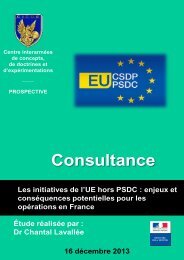Conference
science-research-bulletin-2013-conference
science-research-bulletin-2013-conference
You also want an ePaper? Increase the reach of your titles
YUMPU automatically turns print PDFs into web optimized ePapers that Google loves.
EUROPEAN POLICE SCIENCE AND RESEARCH BULLETIN<br />
SPECIAL CONFERENCE EDITION<br />
GENDER AND POLICING: NARRATIVES OF<br />
CRISIS, CHANGE AND CONTINUITY<br />
Marisa Silvestri<br />
United Kingdom<br />
Keywords: Gender; Policewomen; Diversity; Cult of Masculinity; Police leadership<br />
Abstract: The recruitment of a more diverse police workforce has been central to police reform agendas<br />
across time and place. Police organisations throughout the world have been subject to a number of<br />
high-profile and damning reports that have emphasised the damaging effects of a lack of diversity. Such<br />
damaging effects have been repeatedly cited in relation to both external interactions between police<br />
and citisens, and to the internal interactions between police officers themselves. This paper considers<br />
more specifically the issue of gender representation within policing. It reflects on the histories that have<br />
shaped women’s entry, progression and participation in policing over the past century and considers<br />
some of the contemporary challenges faced by police organisations in maintaining and improving<br />
women’s representation within a climate of economic constraint. Histories of policing have consistently<br />
demonstrated that bringing about change to the organisation is a difficult and often protracted process.<br />
Indeed much research has pointed to the long tradition of police resistance to organisational change<br />
initiatives. Through reflecting on the past and present, it engages with narratives of ‘crisis’ ‘change’ and<br />
‘continuity’ in thinking about the future of gender and policing.<br />
The recruitment of a more diverse police<br />
workforce remains a central feature of<br />
contemporary police reform agendas throughout<br />
the world. Encompassing race, religion, gender<br />
and sexuality, diversity debates within policing<br />
are wide ranging and go beyond the scope of this<br />
contribution. This paper focuses more specifically<br />
on the issue of gender and policing. In 2010, the<br />
Home Office’s ‘Assessment of Women in the<br />
Police Service’ detailed considerable progress in<br />
relation to the increase in female recruitment,<br />
representation and progression in England<br />
and Wales, asserting that ‘female recruitment is<br />
strong and women officers’ chances of promotion<br />
are generally on par with their male counterparts’<br />
(Home Office, 2010, p.3). With the number<br />
of women in policing in England and Wales<br />
indicating an upward trend currently standing at<br />
27 %, there is no doubt that the police service<br />
has done much to demonstrate its commitment<br />
to realising equality, diversity and human rights.<br />
That said, the continued under-representation of<br />
women within the police workforce, particularly<br />
at senior levels, remains a key and consistent<br />
reality for police organisations across the world<br />
(Dick et al. 2013; Van Ewijk, 2012; Prenzler &<br />
Sinclair, 2013). This paper calls into question the<br />
popular mantra that suggests that ‘all things are<br />
equal now’. It reflects on the histories that have<br />
shaped the call for women’s entry into policing,<br />
their progression and participation within<br />
policing over the past century and considers<br />
women’s early experiences of policing in relation<br />
to some of the contemporary concerns about<br />
women’s participation in policing. It is not<br />
my aim here to provide a historical account of<br />
women’s role in policing nor to compare the<br />
progress made by women worldwide. Rather,<br />
through historical reflection, we can begin to<br />
map just how far policing has come in relation to<br />
addressing issues of gender within its workforce<br />
and to think more critically about the concepts of<br />
‘crisis’ and ‘change’. It also affords an opportunity<br />
to speculate about some of the key challenges<br />
that lie ahead in relation to achieving gender<br />
balance and equality, particularly in times of<br />
global economic constraint and austerity.<br />
143





